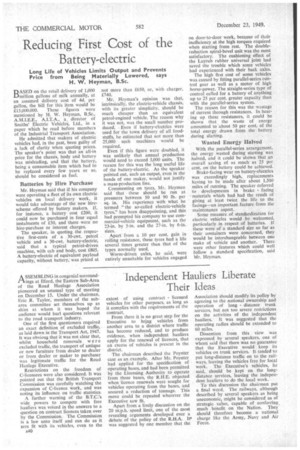Reducing First Cost of the Battery-electric
Page 58

If you've noticed an error in this article please click here to report it so we can fix it.
BASED on the retail delivery of 1,000 million gallons of milk annually, at an assumed delivery cost of 4d. per gallon, the bill for this item would be £15,000,000. These figures were mentioned by H. W. Heyman, B.Sc., A.M.I.E.E., A.I.T.A., a. director of Smiths' Electric Vehicles, Ltd., in a paper which he read before members of the Industrial Transport Association.
He admitted that makers of electric vehicles had, in the past, been guilty of a lack of clarity when quoting prices. The speaker's point was that an all-in price for the chassis, body and battery was misleading, and that the battery, being a consumable item which had to be replaced every few years or so, should be considered as fuel.
Batteries by Hire Purchase
Mr. Heyman said that if his company were operating a fleet of its own electric vehicles on local delivery work, it would take advantage of the new hirescheme offered by battery makers. If, for instance, a battery cost £200, it could now be purchased in four equal instalments of £50, and there were no hire-purchase or interest charges.
The speaker, in quoting the respective first-costs of a 30-cwt. petrol vehicle and a 30-cwt. battery-electric, said that a typical petrol-driven machine, with cab and body, -cost £805. A battery-electric of equivalent payload capacity, without battery,was priced at
not more than £650, or, with charger, £740.
Mr. Heyman's opinion was that, intrinsically, the electric-vehicle chassis, with its greater simplicity, should be much cheaper than an equivalent petrol-engined vehicle. The reason why it was not, was the small number produced. Even if battery-electrics were used for the town delivery of all foodstuffs, he estimated that not more than 25,000 such machines would be required.
Even if this figure were doubled, it was unlikely that annual production would need to exceed 3,000 units. The reason for this was the long useful life of the battery-electric. As the speaker pointed out, such an output, even in the hands of one maker, would not justify a mass-production line.
Commenting on tyres, Mr. Heyman said " that these should be run at pressures between 50 and 90 lb. per sq. in. His experience with what he termed "the so-called electric-vehicle tyres," has been disappointing, and this had prompted his company to use commercial-vehicle equipment, such as the 23-in. by 5-in, and the 27-in. by 6-in. sizes.
Apart from a 10 per cent, gain in rolling resistance, these tyres had a life several times greater than that of the types normally used.
Worm-driven axles, he said, were entirely unsuitable for vehicles engaged on door-to-door work, because of their inefficiency at the high torques required when starting from rest. The doublereduction spiral-bevel unit was the most satisfactory. The cushioning effect of the Layiatb rubber universal joint had saved the trouble which some vehicles had experienced with their back axles.
The high first cost of some vehicles was caused by fitting parallel-series control gear as well as a motor of high horse-power. The straight-series type of control called for a battery of anything up to 25 per cent. greater capacity than with the parallel-series system.
The reason for this was the wastage of current through resistances. In heating up these resistances, it could he shown that the waste of energy amounted to about 50 per cent. of the total energy drawn from the battery during starting.
Wasted Energy Halved
• With the parallel-series arrangement, the energy wasted during starting was halved, and it could be shown that an overall saving of as much as 25 per cent, on the battery could be achieved.
Brake-facing wear on battery-electrics was exceedingly high, replacements having to be made after about 1,500 miles of running. The speaker referred to developments in brake facing materials which had had the result of giving at least twice the life to the facings—an important feature from the maintenance aspect.
Some measure of standardization for electric vehicles would be welcomed, particularly in respect of batteries. If these were of a standard size so far as their containers were concerned, they would be interchangeable between one make of vehicle and another. There were other features which could well follow a standard specification, said Mr. Heyman.




















































































